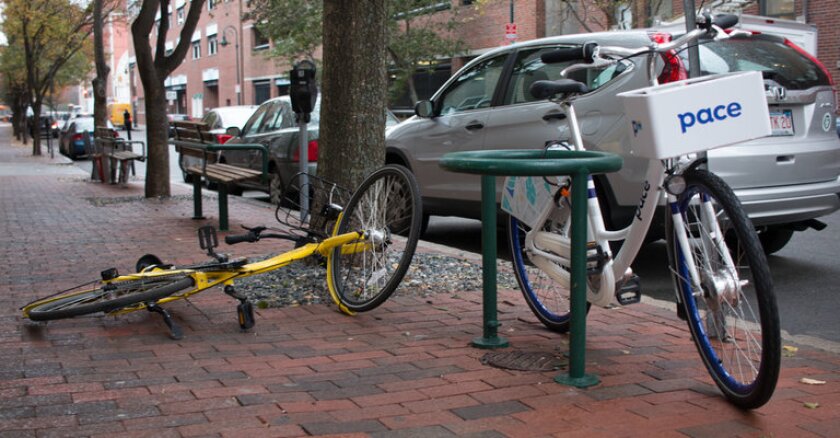Some riders love the convenience of being able to leave a bike wherever they want. But other residents hate the nuisance of finding the free-standing bicycles clogging sidewalks, often blocking walkways and entryways to buildings. (One Washington, D.C.-based blog began cataloging all the worst bike-parking jobs, including on stairways, on fences and even inside stores and lobbies.)
Now one company has a new service that it says offers the best of both models.
Zagster, a bike-share company that has typically served small and medium-sized cities, says its new Pace system will incorporate some of the features of the dockless systems while retaining popular aspects of the more-established dock-based systems.
“With the dock-based system, you have the predictability of just going out of your office in New York, making a left and knowing there is a Citi Bike station there. But if your favorite coffee shop doesn’t have a dock nearby, you’re unable to lock up your bike there,” says Zagster CEO Timothy Ericson. “For a fully dockless system, it’s the reverse. You have to hunt down your bike, hope the GPS is accurate and find a bike. You don’t have the predictability.”
Zagster's hybrid Pace system, which it's rolling out in places like Rochester, N.Y., and Tallahassee, Fla., lets riders use docks or park elsewhere. (Depending on the city, users may get charged more for parking without a dock.) But the bikes can’t be left free-standing; they have to be locked to something in order to end a trip.
“We believe that bikes should be locked to things,” Ericson says. “That whole dockless evolution of dumping your bike anywhere in the street is not good for cities and not good for riders in the long term.”
The company plans to introduce its hybrid system to the 98 city- and university-based bike-share systems it runs. The company can make the transition easier than, say, Citi Bike, because all of its electronic hardware is built onto the bike rather than to the dock.
The new approach from Zagster is yet another reminder of how quickly bike shares are changing. For years, cities had fought to keep “rogue” dockless bike-share systems off their streets, but this year, Seattle, Dallas and Washington, D.C., allowed them to operate. Meanwhile, established bike shares are trying to integrate with transit fare-payment systems, accepting cash payments, using electric-assisted bicycles and better serving poor and minority communities.
That comes amid a national surge in bike-share ridership in recent years. In 2016, ridership increased by 25 percent over the year before, according to the National Association of City Transportation Officials. Of the 28 million trips completed in 2016, 85 percent were made on the country’s five biggest systems: the dock-based services in New York, Chicago, Washington, Miami and Boston.
But the number of systems that relied on smart bikes, rather than smart docks, has taken off since 2014 -- and that was before the proliferation of smart bikes used in dockless systems in 2017.
That could be the direction the entire industry is moving in, Ericson says.
“We believe that in the next five years, all dock-based systems are going away. Some cities will move quicker than others. Some cities are ready today,” he says.
For Zagster, though, the most promising cities are the ones that work with a single service provider and plan how the system should be developed in the long term, much in the way that traditional dock-based systems were designed.
“We have not gotten into places like Washington, D.C., that have allowed multiple operators to come in and put out hundreds of bikes because that doesn’t fit that built,” he says.
Washington is currently conducting a pilot program allowing five private dockless companies to operate alongside the city-owned Capital Bikeshare.
“We don’t believe in filing a permit and then showing up the next day to drop off a bunch of bikes in the city,” Ericson adds.
The first city where Zagster tested its new approach was Rochester this summer, which previously did not have a bike-share program.
Erik Frisch, a transportation specialist for the city, says more people used the bike share than the city had expected. He says the easy-to-use system and $1-a-ride rates helped attract riders. Even though the city had to put its bike share in “hibernation” for the snowy winter, Frisch says he anticipates ridership will be strong again come spring.
Plus, he adds, the experiment was good for the city as a whole.
“We want to be on the cutting edge. We want to be a city that is trying new things,” he says. “This was a really good opportunity for the city.”








